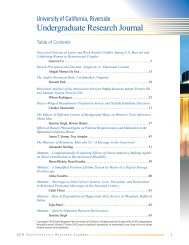Empress Zenobia and Gender Bias Among the Romans
Empress Zenobia and Gender Bias Among the Romans
Empress Zenobia and Gender Bias Among the Romans
Create successful ePaper yourself
Turn your PDF publications into a flip-book with our unique Google optimized e-Paper software.
<strong>Empress</strong> <strong>Zenobia</strong> <strong>and</strong> <strong>Gender</strong> <strong>Bias</strong> <strong>Among</strong> <strong>the</strong> <strong>Romans</strong><br />
Francesca Spolidoro<br />
“Some god, I believe, was angry with <strong>the</strong><br />
commonwealth,who after Valerian’s death, was<br />
unwilling to preserve Odaenathus alive. For a<br />
surety he, with his wife <strong>Zenobia</strong>, would have<br />
restored not only <strong>the</strong> East, which he had already<br />
brought back to its ancient condition, but also<br />
all parts of <strong>the</strong> world everywhere…” (H.A.<br />
“Tyranni XXX,” 15.6)<br />
Banknotes currently issued by <strong>the</strong> Central Bank of Syria<br />
are unique: one side of <strong>the</strong> bill pictures scenes of modern<br />
Syria with script written in English, while <strong>the</strong> reverse<br />
side portrays scenes of ancient Syria with Arabic script.<br />
The English side of this bill pictures a massive, modern<br />
bridge spanning a body of water, leading towards modern<br />
skyscrapers. On <strong>the</strong> reverse side, <strong>the</strong> note displays <strong>the</strong><br />
profile of a woman, posed much like Queen Elizabeth II<br />
on British pound notes. The woman faces an ancient stone<br />
arch <strong>and</strong> colonnade. The Arabic script informs us that<br />
<strong>the</strong> woman is Queen <strong>Zenobia</strong> <strong>and</strong> that <strong>the</strong> ancient, misty<br />
city she gazes towards is Palmyra, <strong>the</strong> principal city of her<br />
kingdom. Palmyra was <strong>the</strong> first century city that stood at<br />
<strong>the</strong> crossroads of <strong>the</strong> Silk Road <strong>and</strong> <strong>the</strong> old Roman roads<br />
that led north towards Antioch, Tarsus <strong>and</strong> Europe, <strong>and</strong> <strong>the</strong><br />
road leading south towards Alex<strong>and</strong>ria <strong>and</strong> North Africa.<br />
Although <strong>the</strong> name <strong>Zenobia</strong> is not as familiar to Westerners<br />
today as Cleopatra, ano<strong>the</strong>r powerful ancient Eastern<br />
queen, for people of <strong>the</strong> Middle East, <strong>Zenobia</strong> remains a<br />
symbol of Arabic power, courage <strong>and</strong> independence.<br />
The story of <strong>Zenobia</strong> <strong>and</strong> Palmyra has many important<br />
points of resonance to our world. Hers is <strong>the</strong> story of an<br />
Arab woman, ensnared between duty to her country <strong>and</strong><br />
rapprochement with Rome, while she continually avoided<br />
domination by her powerful neighbor, Persia. Much of<br />
how we have come to imagine <strong>Zenobia</strong> has come to us<br />
through <strong>the</strong> works of writers, poets, musicians <strong>and</strong> artists<br />
who lived long after her life was over. Chaucer lauds her<br />
beauty, enthusiasm <strong>and</strong> love of learning in “The Monk’s<br />
Tale” from Canterbury Tales (lines 3442-3500). Even<br />
before scholarly study of <strong>Zenobia</strong> commenced in <strong>the</strong> mideighteenth<br />
century, “she had already entered Western art<br />
in <strong>the</strong> beginning of that century when Gianbatista Tiepolo<br />
painted a series of tableaux on <strong>the</strong> walls of <strong>the</strong> palace of<br />
<strong>the</strong> Zenobio family in Venice” (Sou<strong>the</strong>rn, 14). It seems<br />
that much of how we are meant to feel about <strong>Zenobia</strong> has<br />
been romanticized by Western artists, while most of what<br />
we know of her has come to us through <strong>the</strong> biased eye of<br />
ancient Western historians.<br />
<strong>Zenobia</strong> <strong>and</strong> her husb<strong>and</strong>, Odaenathus, ruled on <strong>the</strong> far<br />
Eastern limits of <strong>the</strong> Roman Empire during <strong>the</strong> time that is<br />
commonly referred to by historians as <strong>the</strong> “Third Century<br />
Crisis.” The ancient Sibylline Prophecies - which nearly<br />
all <strong>Romans</strong> accepted as true - predicted that Rome’s glory<br />
would last a thous<strong>and</strong> years, <strong>and</strong> by <strong>the</strong> beginning of<br />
<strong>the</strong> third century that end date was rapidly approaching.<br />
Along with internal administrative problems, <strong>the</strong> power<br />
of Rome was also being challenged militarily in many<br />
important parts of <strong>the</strong> empire. Such a challenge to Roman<br />
hegemony has been ascribed to <strong>Zenobia</strong>. Acting as<br />
Regent for her son, Vallabathus, after <strong>the</strong> murders of her<br />
husb<strong>and</strong> <strong>and</strong> his greatest ally, Emperor Gallienus, <strong>Zenobia</strong><br />
sought to spread Palmyrene influence in <strong>the</strong> Eastern part<br />
of <strong>the</strong> Empire. Sometimes through force, but also through<br />
commerce, <strong>Zenobia</strong> controlled <strong>the</strong> eastern Mediterranean,<br />
from Anatolia to Alex<strong>and</strong>ria (Zosimus, 1.39.2). Roman<br />
leaders, <strong>and</strong> subsequently Roman historians, true to form<br />
when dealing with strong women, were quick to condemn<br />
<strong>Zenobia</strong>’s actions as outright rebellion (White, 60). But a<br />
closer examination of <strong>the</strong> events leading up to Palmyra’s<br />
ascendancy <strong>and</strong> <strong>Zenobia</strong>’s actions during <strong>the</strong> first several<br />
years of her Regency do not lend <strong>the</strong>mselves to <strong>the</strong> idea<br />
that she <strong>and</strong> her son sought trouble with Rome. Instead, <strong>the</strong><br />
importance of <strong>the</strong> alliance between Odaenathus <strong>and</strong> Rome<br />
underlines <strong>the</strong> logic behind her attempt to fill <strong>the</strong> power<br />
vacuum created with <strong>the</strong> king’s death a logical course of<br />
action. <strong>Zenobia</strong> believed she enjoyed <strong>the</strong> same alliance<br />
<strong>and</strong> st<strong>and</strong>ing as her dead husb<strong>and</strong>. By enlarging Palmyra’s<br />
sphere of influence, she attempted to bring order to <strong>the</strong><br />
Eastern Empire <strong>and</strong> protect Roman territory from Sassanid<br />
encroachments into <strong>the</strong> eastern colonies. Many argue that<br />
<strong>Zenobia</strong> overstepped her Roman m<strong>and</strong>ate. However, given<br />
Emperor Aurelian’s reputation for being “over-violent by<br />
nature <strong>and</strong> eager for revenge,” perhaps his response was<br />
“too much like a tyrant…too bloody a method of checking<br />
what should have been cured by a milder means” (H.A.<br />
“Life of Aurelian,” 21.5). One wonders if Aurelian would<br />
have had <strong>the</strong> same response to Odaenathus, or did it just<br />
5 8 U C R U n d e r g r a d u a t e R e s e a r c h J o u r n a l














